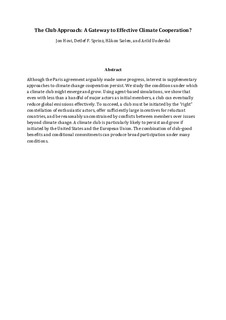Climate Clubs: a Gateway to Effective Climate Cooperation?
Peer reviewed, Journal article
Accepted version
Date
2017Metadata
Show full item recordCollections
- Journal articles [478]
Original version
10.1017/S0007123416000788Abstract
Although the Paris Agreement arguably made some progress, interest in supplementary approaches to climate change co-operation persist. This article examines the conditions under which a climate club might emerge and grow. Using agent-based simulations, it shows that even with less than a handful of major actors as initial members, a club can eventually reduce global emissions effectively. To succeed, a club must be initiated by the ‘right’ constellation of enthusiastic actors, offer sufficiently large incentives for reluctant countries and be reasonably unconstrained by conflicts between members over issues beyond climate change. A climate club is particularly likely to persist and grow if initiated by the United States and the European Union. The combination of club-good benefits and conditional commitments can produce broad participation under many conditions.
Description
This article has been published in a revised form in British Journal of Political Science https://doi.org/10.1017/S0007123416000788. This version is free to view and download for private research and study only. Not for re-distribution, re-sale or use in derivative works.© Cambridge University Press 2017.
